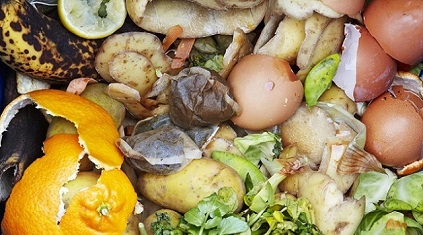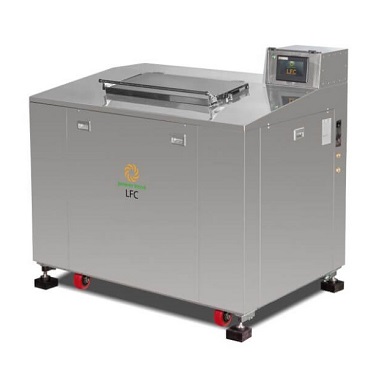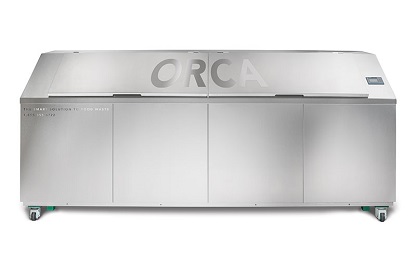 NATIONAL REPORT—Biodigesters that reduce food waste to grey water have been effectively used by hotels for many years now and for good reason. According to Power Knot, a supplier of 10 different models of biodigesters, the machines greatly reduce the cost to dispose of waste food, reduce the size, quantity, and smells of trash bins, eliminate flies and rodents that may be attracted to garbage bins containing waste food, save time and injuries of employees carrying trash outdoors, and allow one to weigh and dispose of food waste in one machine. According to Orca, a supplier of four different models of biodigesters, its machines reduce the carbon footprint of disposing food waste by approximately 90 percent when compared to traditional disposal methods.
NATIONAL REPORT—Biodigesters that reduce food waste to grey water have been effectively used by hotels for many years now and for good reason. According to Power Knot, a supplier of 10 different models of biodigesters, the machines greatly reduce the cost to dispose of waste food, reduce the size, quantity, and smells of trash bins, eliminate flies and rodents that may be attracted to garbage bins containing waste food, save time and injuries of employees carrying trash outdoors, and allow one to weigh and dispose of food waste in one machine. According to Orca, a supplier of four different models of biodigesters, its machines reduce the carbon footprint of disposing food waste by approximately 90 percent when compared to traditional disposal methods.
With an increasing number of hotel customers asking about carbon emissions, biodigester makers such as Power Knot LLC and Orca now make it easy to track and report the CO2 equivalent diverted from landfill. The two companies also offer purchase or rent/lease options—resulting in a no brainer ROI for most F&B operations.
Food waste today most often ends up in landfills where it creates methane, a gas that has 86 times the global warming effect of carbon dioxide. Because up to 40 percent of all food ends up in landfills, reducing food waste has been more top of mind in the travel industry in recent years. While hotel brands and convention centers have been more focused on food waste reduction, so too have the cruise lines. In May of this year, Carnival Corporation & plc, the world’s largest cruise company, announced it had completed the installation of nearly 600 food waste biodigesters across its fleet in support of ongoing food waste management and reduction efforts as part of its overall commitment to environmental compliance.
Food Waste Tracked, Weighed
While some companies focus on measuring food waste prior to serving, companies like Power Knot and Orca tackle (and weigh) the problem after the meal. Orca, for example, with its ORCA portal, can be customized to track individual/different types of food waste that a business has generated.

“The ORCA portal is a cloud-based dashboard that displays the overall food waste volumes diverted through the digester,” says Robert Gates, VP Sales & Marketing for Orca. “This data can be sorted and filtered for different time and date ranges and can empower the food service team to reduce waste by identifying trends and using this information to influence purchasing and production decisions. The ORCA can even be customized to track individual/different types of food waste that a business has generated. The portal will also calculate key environmental metrics such as gallons of diesel avoided, carbon avoided from trucking emissions and methane not generated from landfilling this food waste.”
Power Knot’s President Iain Milnes says his company’s LFC biodigesters include an NFC card reader on the machines that allows one to identify the source or type of waste food placed into the LFC biodigester. This is accomplished by presenting different NFC cards or tags to the card reader, with each card or tag being associated with a particular data set. One can know who used the machine or even monitor the carbon footprint of each category of waste. Users can look on the color touch screen to see the weights by hour, day, week, month, and year and broken down by NFC card usage if that function is used. All data is uploaded to the LFC Cloud.
“For the LFC 1000 you must use an NFC card to use the machine,” Milnes says. “On smaller machines, you can open the machine at any time while still using the card. We know which restaurant or person has loaded the waste. We know today we have wasted 300 pounds of fish. It has helped quantify for the hotelier what specific waste has been inputted.”
Machine Sizes Range Greatly
Orca offers four different biodigester models—ranging from the OG15 which can process an average of 15 pounds of food waste per hour, to the OG100 which can process an average of 100 pounds of food waste per hour. Food waste is added regularly to achieve maximum digestion capacity. ORCA utilizes ORCA Biochips to house its proprietary microorganism solution that digests the food waste. The company’s Gates says his company has been using a polypropylene biochip but just came out with a natural Tagua nut alternative which does the same job as the polypropylene biochip. The nuts are harvested from the Phytelephas Macrocarpa palm tree after they are ripe and have fallen to the ground which means no damage is done to the rainforest during the production process. The Biochips are designed to last for the life of the digester and do not need to be replaced. The microorganism tank is replenished every two months.
Power Knot’s Milnes says his company offers eight biodigester machine sizes and more than 10 different models. Size ranges from the LFC-25, which digests 20 to 165 pounds of food waste per day to the LFC-1000, which digests from 770 to 6,600 pounds of food waste per day. Power Knot’s LFC digesters use either black plastic Powerchips or the recently released Powerchips Green to speed up the digestion rate of food waste in LFC biodigesters. Powerchips Green are made 100 percent from plant-based organic material. Milnes says his company’s Powerchips last up to from two to four years. The microorganisms are added once a year.
Almost all waste food from an industrial kitchen, including fruits, vegetables, meat, fish, cheese, bread, rice, and noodles can go into a biodigester, and the machine can compost both raw and cooked foods. Biodigesters use rotating arms inside the machines to constantly mix the old food, new food, oxygen, and microorganisms to enhance the decomposing function.
Rent, Lease Options Available
Purchasing is not the only option available from Orca and Power Knot. Says Power Knots’ Milnes, “We offer renting and leasing through a third-party finance company and have several such installations in the USA. Renting always includes servicing every six months. For customers that lease, we offer this with or without servicing.”
Adds Orca’s Gates, “A hotelier might choose to rent a machine rather than buying as it requires no upfront capital outlay and produces instant savings against monthly waste hauling invoices which is an expense that they are already accustomed to. We specialize in technology as a service. For one monthly rate, they get the machine, the consumables, the software, the service.” In areas where there is a large concentration of Orca machines, Orca employs its own technicians to service them.

When asked what his hotel clients find most appealing about biodigesters, Gates says, “Hotels that are concerned about the carbon impact of their food waste and are also budget conscious are typically the most motivated to install an ORCA Digester. Our clients are attracted to the ORCA because it is easy to use and can facilitate a reduction in their food waste by measuring and reporting on the amount and type of waste users discard, then through a process of biomimicry will transform the unavoidable food waste into a nutrient-rich liquid for recovery through normal sewage systems, eliminating emissions from garbage trucks and avoiding methane from landfills.”
ORCA service plans are available globally and can be obtained on both a rented or purchased unit.
Are an increasing number of hotel owners investing in biodigesters? “Yes, we are certainly seeing an increased interest in our ORCA digesters as municipal and statewide food waste diversion policies are introduced. Furthermore, many brands are now governing themselves and their operators to both reduce the amount of food waste they produce and to increase landfill diversion rates of unavoidable waste,” Gates says.
Advice to First-Time Buyers
When asked what advice he would give to first-time biodigester buyers, Milnes says, “It is going to be a change to your method of operation. You need to get all the staff on board. Your staff need to know why the change is being made. You must make people know what can go in or not go in. Initial and ongoing training is important.”
Adds Gates, “The first step would be to determine how much food waste the property is generating daily, and this is something that the ORCA team can assist our prospective clients with. We would also recommend that the hotelier determines what their food waste carbon footprint is today and to review their current waste hauling spend. We would also always recommend that the property engage the Chef in the discussion as they are commonly concerned with controlling their food costs and reducing their waste.”
As mentioned, biodigesters from Power Knot and Orca reduce food waste to a liquid that can be disposed of safely in the sewage system. Only rarely is the liquid a concern to a city or town.
Some food waste-reducing machines on the market use a dehydration method that produces a soil amendment. Of the dehydrators, Power Knot’s Milnes says, “They use a huge amount of energy. Basic physics shows you how to dry water. It costs a fortune. You end up with dried waste food, not compost. If you bury it, it will create methane,” adding that he came across one example of a dehydrator user having to send the dried waste food off to an incinerator. Eliminating the trucks involved in the transportation of food waste is of course a main intent of a liquid-creating biodigester.
Biodigesters can easily become a main part of a property’s carbon reduction story and be attractive to those who care about how food waste is managed—potential meetings customers, for example. Also, governments are enacting legislation to keep food waste out of landfills. A biodigester can be a solution in that situation.
Glenn Hasek can be reached at greenlodgingnews@gmail.com.






While the use of aerobic digestion (composting) to avoid disposal of food waste to landfills is commendable.
Wouldn’t it be more environmentally beneficial to send this organic waste to an anaerobic digestion plant?
Anaerobic digestion produces energy and in the right circumstances can even be carbon negative whereas aerobic digestion is always going to be a net energy user and a GHG emitting process as it does not produce any energy and only consumes it.
John, the major upside to composting on-site is the avoiding of all of the carbon impact involved in the transportation of the food waste as well as its potential impact in a landfill where it is destined to emit methane gas. There may be situations of course where anaerobic digestion makes more sense.